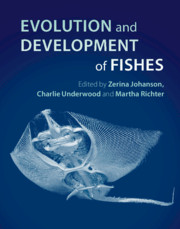Book contents
- Evolution and Development of Fishes
- Evolution and Development of Fishes
- Copyright page
- Contents
- Contributors
- Introduction
- 1 The Evolution of Fishes through Geological Time
- 2 Comparative Development of Cyclostomes
- 3 The Ordovician Enigma
- 4 The Evolution of Vertebrate Dermal Jaw Bones in the Light of Maxillate Placoderms
- 5 Doliodus and Pucapampellids
- 6 The Evolution of Endoskeletal Mineralisation in Chondrichthyan Fish
- 7 Plasticity and Variation of Skeletal Cells and Tissues and the Evolutionary Development of Actinopterygian Fishes
- 8 Origin, Development and Evolution of the Fish Skull
- 9 Evolution, Development and Regeneration of Fish Dentitions
- 10 Development of Head Muscles in Fishes and Notes on Phylogeny-Ontogeny Links
- 11 Evolutionary Development of the Postcranial and Appendicular Skeleton in Fishes
- 12 Evolution of Vertebrate Reproduction
- 13 Links between Thyroid Hormone Alterations and Developmental Changes in the Evolution of the Weberian Apparatus
- 14 Pharyngeal Remodelling in Vertebrate Evolution
- 15 Evolution of Air Breathing and Lung Distribution among Fossil Fishes
- Index
- References
12 - Evolution of Vertebrate Reproduction
Published online by Cambridge University Press: 31 December 2018
- Evolution and Development of Fishes
- Evolution and Development of Fishes
- Copyright page
- Contents
- Contributors
- Introduction
- 1 The Evolution of Fishes through Geological Time
- 2 Comparative Development of Cyclostomes
- 3 The Ordovician Enigma
- 4 The Evolution of Vertebrate Dermal Jaw Bones in the Light of Maxillate Placoderms
- 5 Doliodus and Pucapampellids
- 6 The Evolution of Endoskeletal Mineralisation in Chondrichthyan Fish
- 7 Plasticity and Variation of Skeletal Cells and Tissues and the Evolutionary Development of Actinopterygian Fishes
- 8 Origin, Development and Evolution of the Fish Skull
- 9 Evolution, Development and Regeneration of Fish Dentitions
- 10 Development of Head Muscles in Fishes and Notes on Phylogeny-Ontogeny Links
- 11 Evolutionary Development of the Postcranial and Appendicular Skeleton in Fishes
- 12 Evolution of Vertebrate Reproduction
- 13 Links between Thyroid Hormone Alterations and Developmental Changes in the Evolution of the Weberian Apparatus
- 14 Pharyngeal Remodelling in Vertebrate Evolution
- 15 Evolution of Air Breathing and Lung Distribution among Fossil Fishes
- Index
- References
Summary
The discovery of reproductive structures and embryos in basal jawed vertebrates, in addition to nursery sites, has resulted in a greater understanding of the diversity of reproductive strategies present in early gnathostomes. The presence of both dermal and perichondral components to the pelvic girdle in placoderms, in addition to complex musculature, absent in extant gnathostomes, indicates that the pectoral and pelvic girdles are not as morphologically distinct as previously thought. This suggests that arguments against homology, based on dissimilar skeletal and muscular morphology need to be revised. Evidence that oviparity preceded viviparity is present in the fossil record of placoderms (antiarchs versus ptyctodonts and arthrodires), coelacanths and teleosts. The identification of intromittent structures in placoderms, separate from the pelvic skeleton, suggests that the intromittent organs of placoderms and sharks are not homologous, nor are the gonopodia, modifications of the male anal fin in actinopterygians. These diverse reproductive structures reveal that internal fertilisation and live birth evolved independently and multiple times within the jawed vertebrates.
- Type
- Chapter
- Information
- Evolution and Development of Fishes , pp. 207 - 226Publisher: Cambridge University PressPrint publication year: 2019
References
- 4
- Cited by

